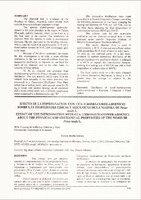Efecto de la impregnación con cca (cromo, cobre, arsénico) sobre las propiedades físicas y mecánicas de la madera de Pinus taeda L.
Effect of the impregnation with cca (chromium-copper-arsenic) about the physical and mechanical properties of the wood de Pinus taeda L.
Abstract
Este trabajo tuvo por objetivo,estudiar el comportamiento de las propiedades físicas y mecánicas de la madera de Pinus taeda L. sin impregnar e impregnada por vacío-presión con preservador CCA (Cromo, Cobre, Arsénico) con tres retenciones, 5, 10 y 15 kg/m3 y la comparación entre ambas.
Para el estudio, se utilizaron seis Árboles con catorce años de edad con un DAP (Diámetro altura del pecho) medio de 31 centímetros, proveniente de Caraguatay, departamento de Montecarlo, provincia de Misiones.
El proceso de impregnado fue realizado en un autoclave de laboratorio, aplicandose el método Burnett, para hidrosolubles; el procedimiento consistió en realizar vacío inicial de 0,5 kg/cm2 (-381 mm de Hg) durante 30 minutos, aprovechando este vacío se llenó el autoclave con el preservante y se aplicó 7 kg/cm2 de presión por un lapso de tres horas. Luego se descargó el producto y se extrajeron las probetas para su estacionamiento y secado bajo cubierta.
Los ensayos de las propiedades físicas y mecánicas se determinaron según lo establecen, las normas técnicas IRAM (Instituto Argentine de Rationalization de materiales), ASTM (American Society for Testing and Materials) y DIN (Deutsche Industrie Norm). Para ello se usaron una balanza Metier de precisión, balanza digital, calibres, estufas, desecadores y una máquina universal de ensayos SIFIC, de 10 toneladas de capacidad.
Los valores obtenidos de las propiedades de la madera sin impregnar e impregnadas con las diferentes retenciones fueron procesados estadísticamente y analizados. Del análisis de los resultados, sobre las propiedades físicas y mecánicas,
se determinaron las siguientes conclusiones:
1) Las propiedades físicas como ser los pesos específicos a distintos porcentajes de humedad no son afectadas por las retenciones de CCA en la madera.
2) Las contracciones tanto en el sentido tangencial como radial en las maderas impregnadas son menores, significando esto una ventaja para las mismas.
3) Las propiedades mecánicas de resistencia a la flexión estática, compresión paralela a las fibras, tracción perpendicular a las fibras, dureza Janka radial y tangencial y corte paralelo radial, no han denotado diferencias estadísticamente significativas con respecto a la madera sin impregnar. Sin embargo el tratamiento ha producido un efecto positivo en la dureza Janka transversal y en el corte paralelo a las fibras tangencial. This work had by objective, to study the behavior of the physical and mechanical properties of the wood of Pinus taeda L. without impregnating and
impregnating by empty - pressure with preserving CCA (Chrome, Copper, Arsenic) with three retentions, 5, 10 and 15 kg/m3 and the comparison
between both.
For the study, were used six fourteen years old trees with a midle diameter of 31 centimeters, originating from Caraguatay, department of Montecarlo, Misiones province.
The process of impregnation was accomplished in an autoclave of laboratory, being applied the Burnett method, for hidrosolubles. The procedure consist of accomplishing initial vacuum of-1 kg/cm2 (- 381 mm of Hg) during 30 minutes; taking advantage of this vacuum, the autoclave was filled with the preservative and a pressure of 7
kg/cm2 was applied pressure during three hours. Then, the product and was unloaded and the samples extracted for dryieng under cover.
The samples of the physical and mechanical properties were determined according to establish it, the technical procedures IRAM (Argentine Institute
for Rationalization of materials), ASTM (American Society for Testing and Material) and DIN (Deutsche Industrie Norm). For this were used a of precision
scale Metier, digital scale, calipers, stoves, driers and schemes and an Universal machine of trials SIFIC, of 10 tons capacity.
The values obtained from the properties of the wood without impregnation and impregnated with the different retentions, were estadistically processed and analyzed. Of the analysis of the results, on the physical and mechanical properties, were determined the following conclusions:
1) The physical properties as the specific weights to different percentages of humidity were not affected by the retentions of CCA in the wood.
2) The shrinkage so much in the tangential sense as radial in the impregnated woods were smaller, meaning this an advantage for the same.
3) The mechanical resistance properties to the statics flexion, parallel compression to the fibers, perpendicular traction to the fibers, hardness tangential and radial Yanka and paralell radial cut, they have not denoted statistically meaningful differences with respect to the wood without impregnation, however the treatment has produced a positive effect in the hardness transverse Yanka and in the parallel cut to the tangential fibers.
Collections
- Revista Yvyraretá [360]
The following license files are associated with this item:




